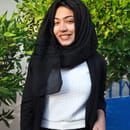What does it mean to be non-binary? Most people– especially those who have never come in contact with a non-binary person before– tend to picture someone who is white, thin and androgynous. A person with short hair and lengthy limbs dressed in masculine, monochrome clothing, a look popularized by celebrities like Ruby Rose and Dove Rain. While that is a perfectly valid form of gender expression, it isn’t really a fulsome depiction of what it means to be non-binary.

It’s not an unfounded misunderstanding. The typical stereotype portrays non-binary identies as the shade of purple residing on the scale between blue and pink, but that’s not quite right. Imagine gender as a color wheel in which colors blend into one another; no one color having perfectly defined lines.
The truth is, non-binary can look like anything. Since gender identity spans all the colors and beyond, it stands to reason that the physical expression of those identities will vary just as greatly. Yet, people always seem to return to the image I described above: white, thin adrogynous and most likely assigned female at birth (AFAB).
Why is that? Where did this image and expectation come from?
The first component that comes to mind is media. Cisgender women are considered more consumable to the public eye. Therefore, they are the faces used to sell new ideas and/or appear more often in the media. Non-binary celebrities like Ruby Rose or Miley Cyrus, those who fit into the easily consumable image of white, thin and conventionally attractive, are too often the only widespread representation of non-binary people.
Unsurprisingly, the media doesn’t show the whole story. There are those who are assigned male at birth (AMAB), people of color and people of all different sizes who identify as non-binary. It’s the narrow, specific representation of non-binary people that leads to generalizations and misunderstanding non-binary identities as an AFAB phenomenon and therefore not entirely legitimate because, let’s be honest, few people take women (or those perceived as women) as seriously as they do men.

There’s an inherent sexism that assigns prestige to the hobbies, careers and fashion choices that have been labeled masculine. Whereas, interests and aesthetics labeled as feminine are seen as somewhat silly, trivial or embarrassing. For example, it’s far more socially acceptable for women to wear pants than it is for men to wear dresses. It is, on some level, seen as a good thing for women to strive to be more masculine or assimilate into male-dominated spaces. On the other hand, it is seen as ridiculous for men to want to be more “like women”. It’s these embedded ideas/feelings that lead to some people misinterpreting non-binary identities as a sort of scheme to reach for male privileges or freedom without sacrificing any of the benefits or “legitimate” core identity that comes with womanhood.
The truth is, being non-binary isn’t some delusional attempt at a power grab; it is merely interpreted that way because the idea of The Two Genders™ is so ingrained within our society, that it is seen as ludicrous and impossible to exist outside of the two without a sinister agenda. There is no language, no social role for anyone who exists beyond the labels “man” and “woman.” Which is why when trying, or not trying as the case may be, to understand non-binary identities, it’s interpreted on the same singular axis from male to female. It’s why when an AFAB person tries to be something beyond male or female, they are still seen as trying to emulate men, rather than something separate from the binary entirely. Claiming to be neither leaves non-binary people without a social role. And since people aren’t taking those who claim to be be neither male nor female seriously, non-binary people are often treated as either tomboyish women or as gay men.
Non-binary identies should be understood as just that – unassociated with the binary. They shouldn’t be categorized like a diet fad, less calories, more filling: less dresses, more undercuts, but as their own separate experience. Non-binary identies aren’t the consumable, low carb, alluring andrgoney the media portrays or silly women trying to have the best of both worlds. Rather, it can look like anything and can come from anywhere; any sex at birth, any race, any body type. It’s not just Woman-Lite.



